486 Search Results for opportunities
November 1, 2021
by Carole Zangari -
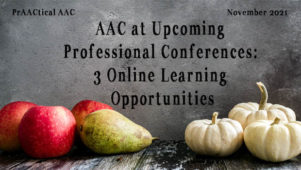
If you’re new to the practice of AAC or just want to expand your knowledge base, consider making plans to attend a conference where you can learn from a variety of AAC stakeholders and make connections with like-minded individuals. Here are some suggestions for upcoming events with virtual options. NOVEMBER: #TalkingAAC DECEMBER: ASHA’s Expanding AAC: Accessible Strategies for Functional Communication JANUARY: Assistive Technology Industry Association (ATIA) Hope to see you there!
August 4, 2014
by Carole Zangari -

Build it and they will come.
January 27, 2014
by Robin Parker -
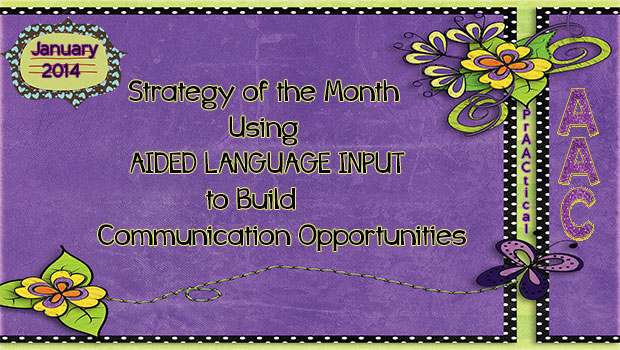
We can not write, speak or do enough Aided Language Input (ALI). If we expect learners to speak AAC, we must speak AAC to them. It is difficult enough to learn a language and imagine if no one spoke it to you in the language you were expected to speak…But there are so many more reasons to do ALI. Aided Language Input (ALI) belongs in the context of communication opportunities. It is modeling AAC style. Once we model a target language concept AAC style, then add the wait and signal strategy, the learner then knows it is their communicative turn. Especially if you wait with the raised eye brow signal. They often will take their turn expressively. But, if they do not take the communicative opportunity to take their turn, there are gestural, visual, verbal, and physical prompts that can be implemented. In other words, they can make use of... [Read More...]
January 13, 2014
by Robin Parker -
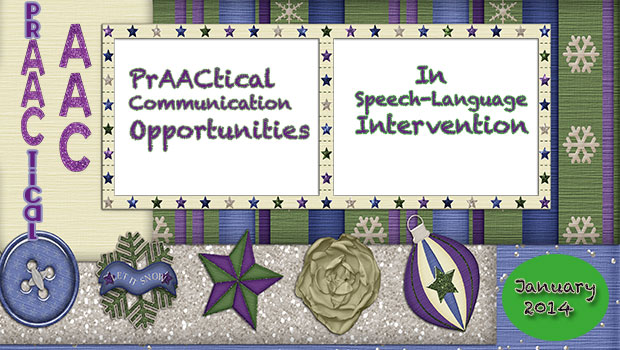
Planning for communication opportunities in every aspect of speech-language therapy helps ensure productive use of time and effort for both clinician and learner. It is not enough to talk to a student, it is not enough to provide fun activities without lots of opportunity for active participation and more specifically communication initiation. Another word for communication initiation/opportunities is communication temptations. Communication temptations are structured situations designed to entice a variety of specific communication functions or semantic relations (Wetherby, 1988). There needs to be lots of times where there is targeted modeling and then a specific, obvious reason for the learner to be the initiator of communication. A temptation to communicate. Take a look at this sample therapy session for frequent and multiple communication opportunities. Please let us know a favorite or creative communication opportunity that you use. PrAACtical Considerations Meaningful AAC Goals– All quality speech-language intervention sessions start with meaningful... [Read More...]
September 7, 2013
by Carole Zangari -
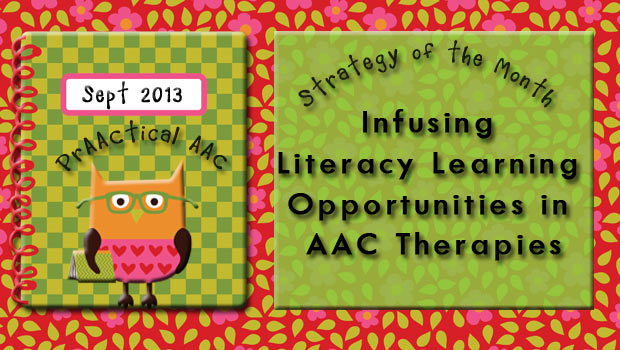
Most of our conversations with SLPs about teaching literacy to individuals with AAC needs revolve around the ‘How’s.” “How can I possibly teach reading and writing? I don’t have enough time with her to teach language and communication!” “How am I going to teach reading to someone who can’t sound out words? Or writing to someone who can barely use a pencil or keyboard?” In general, SLPs WANT to teach literacy skills. They understand the importance of this skill set and how it can level the playing field for people with communication difficulties. They know that reading and writing are inherently linked to speaking and listening. They know that literacy is a powerful key that unlocks many, many doors. And yet, getting from there to the point of actually teaching clients with AAC needs to read and write is not something we do enough of. This month, we’ll look at ways... [Read More...]
July 13, 2013
by Robin Parker -
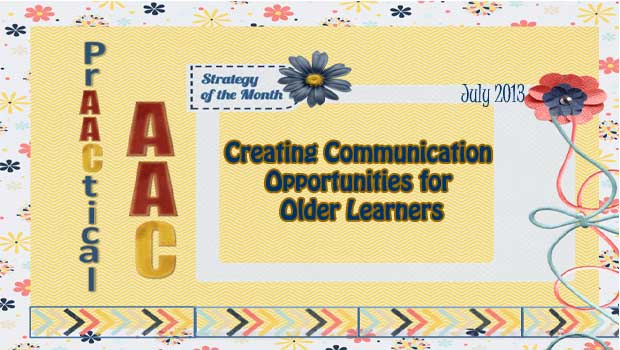
The Strategy of the Month involves AAC and the ‘older learner’. The ‘older learner’ involves a range of ages (We are ‘older learners’ for way longer than we are children) as well as a wide range of functioning levels. Even with this variation though, we know that ALL older learners can learn. There are challenges with ‘older learners’ that need to be addressed in order to facilitate spontaneous and generative communication and language. The challenges may result from years and years of going to intervention (some of it effective, some not), from perceived failure by the learner and/or the professionals, or may even just be related to that ‘teenager or adult’ independent streak. These challenges can definitely be overcome in order to help develop a functional and robust communication system for ALL learners. Just remember respect the learner as a competent teenager or adult (e.g., think what a typical language... [Read More...]
April 28, 2012
by Carole Zangari -
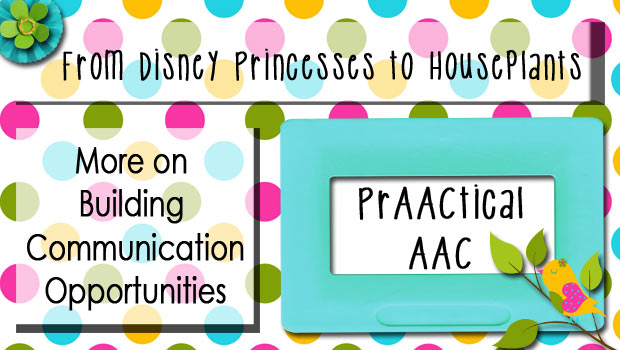
Mining everyday routines at home, in school, and in therapy sessions for communication teaching opportunities is a great way to get started in boosting the effectiveness of AAC intervention. We are inspired when we see clinicians enhance their clients’ learning by making subtle, but important changes. – I was thrilled to hear one SLP talk about how she ‘found’ more AAC practice for a teenager by offering more choices in her therapy games. Once he chose a TV character for the activity, LeVon then had to specify what action he/she would do (e.g., dance, drive, clap) and a location in which to do it (e.g., home, school, beach). Agent, action, location. Hmm…sounds like a good start for sentence-building, with a little aided language input and expansion thrown in for good measure. “Quinn drive beach.” “Yes. Quinn drove to the beach in his truck.” And it gives us great pleasure to... [Read More...]
April 21, 2012
by Carole Zangari -

– Guest post by Stefanie Finocchio, M.S., CCC-CF As we’ve said before, we feel incredibly fortunate to have made our careers educating the next generation of SLPs. Sharing what we’e learned about AAC, AT, autism, literacy, and language intervention with graduate student clinicians is a challenge we both love. In this post, we share the wonderful ideas of a recent graduate, Stefanie Finocchio. Although she has only been out of grad school for a few months, Stefanie has some very prAACtical ideas about how to create communication opportunities for young children who are learning to use AAC. – One of my favorite “go-to” activities/games that I use frequently with my students diagnosed with autism is the Playskool Busy Gears game by Hasbro. It comes with 11 plastic gears of all different sizes and colors. Once a gear is placed on the board, you hit a button on the bottom and... [Read More...]
April 14, 2012
by Carole Zangari -
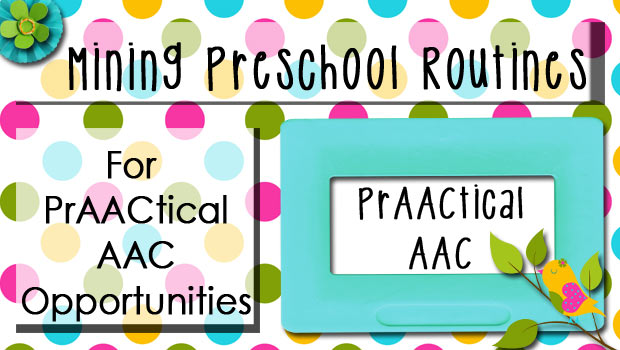
Meet Jenna, a spirited little girl with developmental delays who is learning to communicate using multiple modalities. Follow her along this morning as she goes to her preschool and gets dozens of opportunities to practice the AAC skills she is learning. 101 opportunities to practice target skills before lunch? It’s a piece of cake with this well-oiled preschool team! Jenna’s communicative functions are noted in CAPS and her communication modalities are in italics. – Let’s watch and see how Jenna is getting all that practice in as she goes about her day. – 7:55 1. Enter the building, pause at a trained adult communication partner (receptionist) for Jenna to GREET with a vocalization and wave 2. ANSWER a social question (“How are you?”) with gesture (thumbs up) 3. Say GOODBYE with a wave 4. Once in the classroom, repeat GREETINGS with teacher, aide, and a friend. 5. ASK for HELP putting... [Read More...]
April 7, 2012
by Carole Zangari -
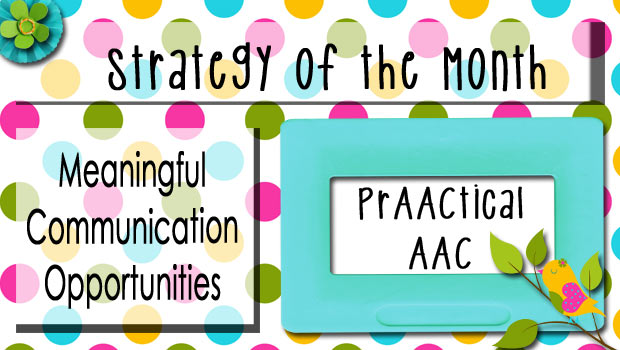
April is springtime where we live and spring is a time of beginnings. It’s fitting, then, that our AAC strategy of the month speaks to the very beginning of AAC intervention. Learning how to create focused opportunities to teach or practice an AAC skill is a pivotal skill for SLPs. The concept is a simple one: create an environment in which the learner WANTS or NEEDS to display the target skill. – Communication opportunities are related to the concept of communicative temptations. As SLP blogger Becca Jarzynski of Child Talk puts it “Communication temptations are pretty much just what they sound like: we set up the environment to tempt children to communicate with us.” Stop by and read her excellent post here . While Becca focuses on their use with young children, the approach can be used with people of any age. – Tempting people to communicate is all about... [Read More...]









